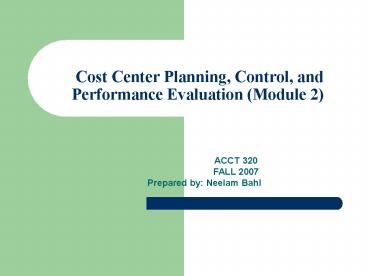Cost Center Planning, Control, and Performance Evaluation Module 2 - PowerPoint PPT Presentation
1 / 13
Title:
Cost Center Planning, Control, and Performance Evaluation Module 2
Description:
Example of cost objects are cost center, production order, project etc. ... Recording actual costs against cost centers and Error correction: ... – PowerPoint PPT presentation
Number of Views:1448
Avg rating:3.0/5.0
Title: Cost Center Planning, Control, and Performance Evaluation Module 2
1
Cost Center Planning, Control, and
Performance Evaluation (Module 2)
ACCT 320 FALL 2007 Prepared by Neelam Bahl
2
Primary Function of Controlling
- Is to accumulate costs in relevant controlling
objects to support the analysis of necessary
data and to answer business questions. - controlling objectsor cost objects are the
objects which incur costs. Example of cost
objects are cost center, production order,
project etc.
3
Learning Objectives (Module 2)
- To familiarize students with the SAP R/3
functions involved in - 1. Setting up organizational units involving
cost centers - 2. Recording actual costs against cost centers
and - 3. Allocating actual costs among cost centers.
- Modules 2, Three exercises
- First exercise
- - Setting Up Organizational Units Cost centers
- Second exercise
- actual transactions will be recorded to capture
the activities. - Third exercise
- allocating costs among different types of cost
objects
4
Case Overview
- Company 3000 in Controlling area 2000 has decided
to offer a new service to its computer customers
that involves - Field technical support and service which will be
provided on the basis of yearly contracts
5
First Exercise
- Setting Up Organizational Units
- Setting up three cost centers
- Clerical Support - headed by Jim Johnson
(4100-XXX) - Will provide information and communication
services to the field service center and to
custodial support - Field Service Center - headed by Jenny Smith
(4110-XXX) - Will provide the field support to customers
- Custodial Support - headed by Ruth Jones
(4120-XXX) - Will provide occupancy and janitorial services to
the field service center and to clerical support
6
First Exercise
Ruth Jones
Jim Johnson
Jenny Smith
X
X
X
7
Second Exercise
- Recording actual costs against cost centers and
Error correction - All costs/expenses that arise from transactions
with external parties (e.g., purchases of
supplies, payment of telephone charges, purchase
of insurance) will be initially recorded in FI
and automatically transferred to CO as primary
cost elements. - Costs/expenses that arise from internal
transactions among organizational units and/or
cost objects (e.g., allocation of cafeteria
costs to cost centers, transfer of cost center
costs to a production order) are recorded within
CO as secondary cost elements. - Error correction
- R/3 system provides a reposting function that
may be used to correct errors in original
postings. Execution of the reposting function
leads to the creation of a reposting document,
which provide an audit trail for the correcting
entry
8
Third Exercise
- Allocating Costs Among Cost Centers
- Two methods of allocating costs
- Transaction-based allocation Costs may be
allocated in real time as activities are
performed. - Periodic allocation Costs may be allocated in
delayed time at the end of a period (month).
9
Third Exercise
- Two methods of allocating costs
- Transaction-based allocation
- a company may monitor day-by-day activities of
sender and receiver cost centers and the flow of
resources among those cost centers. In order to
use transaction-based allocations, a company must
capture activity usage as it takes place on an
hour-by-hour, day-by-day basis.
10
Third Exercise
- Two methods of allocating costs (continued)
- Periodic allocations
- Three of the major R/3 periodic allocation
approaches - Surcharge allocation allocated based on
specified surcharge - Tracing factor allocation (has two alternatives)
allocated based the relative proportions of a
tracing factor - Assessment
- - This method may be used to allocated
primary and/or - secondary cost
- Distribution
- - This method may be used to allocate
primary cost elements - only among the sender and receiver
cost centers - Activity allocation allocations of overhead
based on the activity provided to a cost center
by another
11
Process Flow
- Define a cycle
- A collection of rules for cost allocation
- defining sender-receiver relationships for these
allocation types by specifying which object
allocates the costs and to which object are the
costs to be allocated? - Define segments for a cycle
- A segment consists of the following elements
- Sender objects, whose values to be allocated are
computed using the same rules - Receiver objects, whose allocation bases are
computed using the same rules
12
Process Flow
- Specify the Tracing factor
- The basis for allocations 9202 employee head
- Execute the cycle
- Check the debits and credits by running a report.
13
Cycle
Name
Cycle
Date
Planned or actual values
Segment
100 allocation
Sending cost center
Sender/ Receiver
Which costs to be assessed
Receiving cost center(s)
Tracing Factor
SKF

